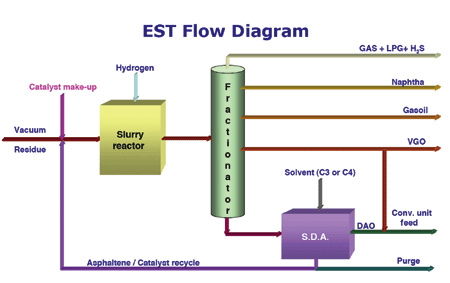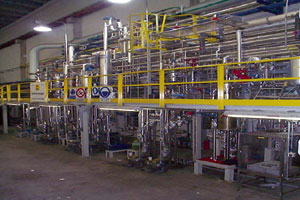 Technology from Europe: Technology from Europe:
Italy
Heavy oil/ resid upgrading process benefits upstream and downstream
With heavy oil, tar and bitumen resources in the trillions of barrels worldwide, much attention is being focused on optimizing the paths that these unconventional resources take to becoming useful fuels and products. The ENI Slurry Technology (EST) was developed by Snamprogetti S.p.A. (now part of Saipem) and EniTecnologie S.p.A. It can benefit both upstream and downstream businesses by upgrading high-carbon-to-hydrogen liquids, whether the source is from Canada’s oil/ bitumen sands, Venezuela’s extra-heavy crude, or the resid that is an important internal byproduct in oil refining.
There are two ways that high-carbon feedstocks can be upgraded: either remove carbon or add hydrogen. Carbon rejection is cheap, but results in lower-quality products and a large amount of coke and pitch. Adding hydrogen results in higher-quality products and partial conversion to fuel, but you’ll have to get that hydrogen at some added cost. Regardless of the hydrogen source, it must be combined with the existing heavy feedstock. There are three hydrocracking methods by which this can be done: fixed bed, ebullating bed, and slurry. EST is a slurry hydroprocess that is combined with solvent deasphalting of the vacuum residuum effluent. It contains a feedback loop that recycles the asphaltenes, along with a molybdenum-based catalyst, back to the slurry reactor, see Fig. 1.
 |
Fig. 1. EST slurry hydroprocess, with solvent deasphalting of the vacuum resid, plus a feedback loop to recycle the asphaltenes and molybdenum-based catalyst.
|
|
This process can provide high concentrations of a very efficient catalyst that will maximize upgrading. There is almost no waste in the process, with nearly complete conversion possible and some leeway in selecting distillates and the products to which the process is driven. Hydrogen consumption is efficient and, while not cheap, sensitivity analysis shows that is affordable even at high natural gas prices, since the end products are high value as well. Although the initial EST process still results in a majority of the products regarded as “heavy,” they are nearly contaminate-free, and ready for further processing.
Overall, hydrodemetalization is greater than 99%, and hydrodesulfurization is greater than 75%, Conradson carbon residue is reduced by more than 90%. Diesel fuel with less than 10 ppm sulfur and a cetane number above 52 can be produced.
Feedstocks can be from upstream or downstream sources. These include atmospheric residues, oil sands bitumen, heavy and extra-heavy crudes, deasphalted oils, vacuum residues and thermal or visbreaker tars. Products are deasphalted oil (DAO), vacuum gas oil (VGO), gasoil/ diesel, naphtha, light gases, and a very small purge of asphaltenes. The process can be optimized to produce more gasoline or more diesel by further processing the VGO and DAO products in a conventional catalytic cracker or a hydrocracker.
Slurry processes, in general, are attractive for heavy feedstocks. However, in contrast to other slurry processes, EST is primarily a hydrogen-addition process with some of the advantages of carbon rejection, resulting in a better quality of product. Dispersed-catalyst systems are not prone to plugging and, without the coke/ pitch to clog the system, as is the case with other catalytic methods, high metals and high Conradson carbon-residue feeds can be processed.
Residue is an ongoing problem in refineries, since such a large volume (as much as 30 – 40%) can be generated. This is worsened by the fact that upstream feedstocks are, on average, containing more carbon and less hydrogen over time. In addition, environmental requirements are becoming stricter. At the same time, the production of heavy crude oils is likely to increase. For these reasons, coupled with increasing demand for light and middle distillates, upgrading technologies such as EST will continue to be of keen interest.
Venezuelan firm PDVSA and ENI are jointly exploring development of EST and PDVSA’s HDH+ (Hydrocracking, Distillation and Hydrotreatment) technologies for applications in extra-heavy crude processing. ENI has been operating a very small, proof-of-concept EST plant, since 1999, Fig. 2. 
 |
Fig. 2. ENI has been operating this small (1/3 bpd), proof-of-concept EST plant since 1999.
|
|
|

 Technology from Europe:
Technology from Europe:


